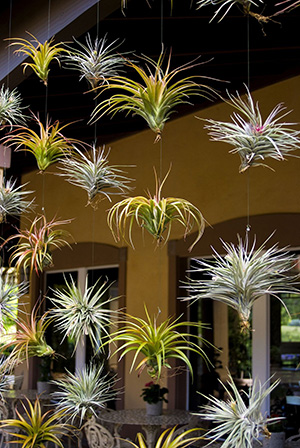Gardening Up in the Air
By Tammy Thornton

True confessions of a gardener: houseplants fear me. I bring home a beautiful, healthy plant from the store and the other half-dead plants look on with pity and hang their heads a little lower. Flowers in my garden rely on nature and usually fare pretty well, but indoors, they rely on me.
Fortunately, I’m an optimist. So for my next indoor gardening project, I’m excited about Tillandsias, more commonly known as air plants. They have grown in popularity over the last few years, make great gifts, and are apparently easy to grow. The air plants I recently purchased came in glass ornaments atop a bit of moss. It’s basically a miniature terrarium that can be hung from its string.
Many houseplants succumb to overwatering and soggy soil. But air plants do not grow in soil or water. Caring for them is simple. They need high humidity, which can be attained by frequent misting, and a weekly bath. Immerse them in a bowl of water for about 20-60 minutes. Once hydrated, remove them from the water and allow them to drip dry upside down to drain any water accumulated around the crown, since they can rot if not properly drained.

Air plants are types of epiphytes, from the Greek words for “plant+upon”. They attach themselves to other plants, often trees, and draw their nutrients and moisture through their leaves from the air, rain, and the surface of the supporting plant. Unlike parasites, however, they are not negatively affecting the host. They are native to the southern United States, Mexico, South America, and Central America.
Since they have this unique growing habit, air plants can be displayed in creative ways without the bounds of a pot of soil like a typical houseplant. In addition to growing them in the globe terrariums normally sold alongside air plants, you can also plant them in seashells, sea urchin shells, or driftwood. For a trendy look, place them in an open geometric-shaped container. Get creative. Just remember to display them in a way that they can be easily removed for their weekly bath.
If you are successful in your air plant care, you may be fortunate enough for your original plant to have offsets, called pups. This occurs as the air plant matures; it may even flower. Sadly, both of these events occur near the end of its life cycle. Like Charlotte in her web, the old life gives way to the new as the cycle begins again. As the “baby” plant matures, it can be separated to become an independent plant with a new home.

Air plants can be found online or at your local nursery. In either case, your new plant will probably be suffering from lack of hydration, especially if packed in a mailing envelope. Give your new friend a much needed bath right from the package to ensure a good transition to its new home.
Shore local would love to hear your success stories or mishaps about this trendy plant. Send your questions, comments, or gardening blunders to the shorelocalgardener.com on air plants or any gardening tales. Look for our upcoming issue to learn more about another popular houseplant: succulents.
Tammy Thornton is a mom of four, a substitute teacher, and a Sunday school teacher. She is passionate about gardening and cooking, and loves the beach.





